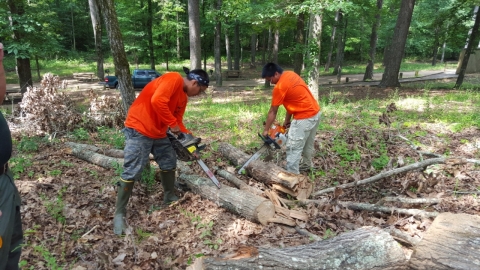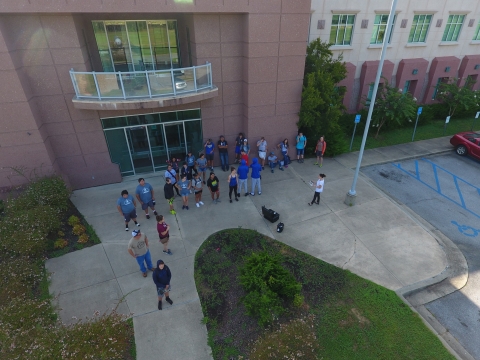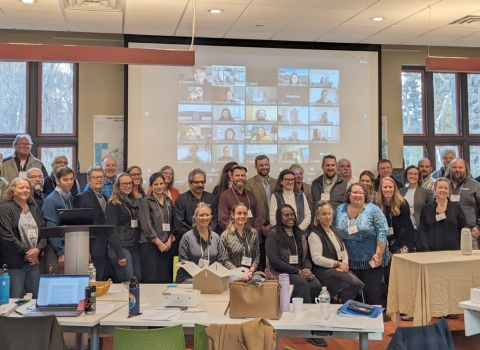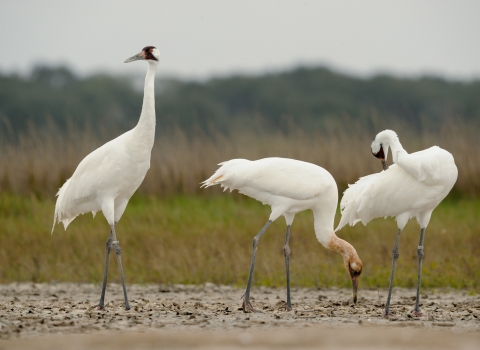She huffed along, listening for a hoof in the mud, a snort in the trees. Yes, Mitzi Reed had always wanted a career in the outdoors, but she never signed up to be a cowgirl.
No one in her collegiate biology classes had ever taught her to use a lariat. Still, there she was, the Wildlife Director/Tribal Biologist for the Mississippi Band of Choctaw Indians, chasing cows across tribal lands. It began in the winter of 2016 as Reed strolled a path meandering through a tribal recreation area. She saw colors in the distance – black, white, and brown. She got a little closer. Cows. Thirteen of them.
Reed, a tribal member whose real job is serving as the Director of the Choctaw Wildlife and Parks working with a fellow conservationist to secure conservation funding for the Choctaw, did what needed to be done.
She alerted her wildlife rangers, who found the cattle’s owner and requested that he kindly remove his bovine trespassers. The owner caught nine. That left four. He called some cowboy friends to head ‘em up and move ‘em out. The quartet had other ideas. The cows took off on a gallop toward Lake Pushmataha. The cowboys took chase. So did Reed and her wildlife crew.
“We joined the race back and forth around Lake Pushmataha the entire day until the cowboys were able to tie off the cows near the edge of the lake,” Reed recalls. “The next question was: How to get them out? Because we sure were not going to be able to walk them out with a leash.”
Cowboys, wildlife rangers, and biologists can be resourceful. The best way to remove the wayward cows, they decided, was to load them into a boat and ferry the cows across the lake to a waiting trailer. This was a tricky, one-cow-at-a-time process. Reed watched from behind the steering wheel of the boat as one interloper after another made the slow passage across the water. The last unwanted visitor left at 10:30 p.m.
Reed, cowgirl for a day, still smiles when she recalls the impromptu round-up.
“Man,” she says, “I love my job!”
A job that requires Reed and Jessica Lewis, the Tribe’s environmental scientist, to ensure the Choctaw embrace conservation – not just of their natural resources, but of their culture, too. Working through the Tribe’s Wildlife and Parks Program and Environmental Protection Office, Reed and Lewis are at the forefront of seeking grants that fund an array of programs for the Choctaw. Grants have paid to modernize dated records, fight invasive species invasive species
An invasive species is any plant or animal that has spread or been introduced into a new area where they are, or could, cause harm to the environment, economy, or human, animal, or plant health. Their unwelcome presence can destroy ecosystems and cost millions of dollars.
Learn more about invasive species , teach the next generation about conservation, and more.
“I love working for the Tribe,” says Lewis, who – like Reed -- originally planned to be a veterinarian but decided she liked working outdoors more. “I can’t ask for a better job.”
Or a more challenging one. Working with the Tribe, Reed and Lewis say, is a constant reminder that they never have sufficient workforce and money to achieve all the goals they’ve set.
Service grants
Reed is the sole biologist for the Tribe in the wildlife program; Lewis juggles an array of duties that are often individual positions in larger programs.
“We need people, and we need to figure out how to keep them,” says Lewis.
That’s where grants help. The U.S. Fish and Wildlife Service (Service) has played an active role in funding various initiatives through its Tribal Wildlife Grant Program. The program helps federally recognized tribes develop and implement programs that will benefit wildlife and their habitats.
For the Choctaw Tribe, the grants have underwritten an array of conservation efforts.
Grant money helped the Tribe create a wetlands education area for hosting education and outreach programs. Lewis is developing plans to build an outdoor classroom - complete with a presentation area, seats, and signage. She also hopes to plant a pollinator garden to educate people about the importance of pollinators.
Another Service grant, in conjunction with two wetland development grants from other sources, is helping the Tribe update its National Wetlands Inventory. The improved inventory will include the tribal tract’s whole watershed and will examine drainage – where it is, its source, and where stream modifications are taking place in historical wetland locations.
The update is as overdue as it is necessary: The Tribe has been relying on an inventory dating to 1980.
“Technology has come so far since then,” says Lewis. “And this update will allow me to examine both the new and old satellite images and compare them before I head to the field for an environmental assessment.”
At the same time, the Tribe is trying to modernize and improve its environmental code.
Reed is dealing with an old code, too. “The hunting and fishing code is outdated and includes restrictions on hunting that are no longer necessary due to the strides made in conservation efforts,” says Reed.
The Environmental Protection Agency (EPA) is helping. An EPA grant is paying to document conservation wisdom handed down from one tribal generation to the next. Lewis is overseeing the creation of that inventory, officially called traditional ecological knowledge, or TEK. The money will help fund an intern position that will focus on interviewing tribal historians and the tribal museum keeper, collecting TEK and compiling it.
“A lot of people don’t realize that what they’re doing is TEK because it’s what they’ve done their whole life,” says Lewis. “They don’t realize it’s conservation.”
But most grants have time limits -- and when a grant runs out, a program can lose capacity that has been gained. Lewis and Reed can recite an annual dilemma: hire someone with grant money, train them, then wish that coworker good luck when the grant expires 12 months later.
War on invasive species
Grants help keep invasive species under control, too.
The Tribe, like just about every other large-tract landowner in northern Mississippi, is plagued by invasive feral hogs. In 2016, the Service approved a Tribal Wildlife Grant to help combat the hogs, which devastate landscapes with their incessant rooting.
“It’s a full-time, 24/7 job,” says Reed. “We get areas where we start seeing a lot of activity, so we concentrate our efforts there for six to eight weeks, maybe three months even.”
The war on invasives isn’t limited to hogs. Several invasive plant species are present on tribal lands, too. Reed and Lewis hope to use more Service grants to work on managing those unwanted species.
Grants are also the lifeblood of biodiversity surveys, which Reed and Lewis are keen to conduct. One location they have in mind is the Cave Mound, a sacred site dating back about 1,700 years. It is integral in the origin stories of several tribes, including the Choctaw, Creek, and Cherokee. The Choctaw call it Nanih Waiya.
“The species in this location are not very well studied,” says Lewis. “We hope to find some unique species or maybe some surprises like an endangered species.”
They want to use Service grants to make that happen.
Lewis and Reed also hope to develop a tribal-specific endangered- and threatened-species list with grant funds. This list would include species that may not be federally or state-listed as endangered or threatened but would feature species that are culturally significant and no longer occur in the abundance needed to continue time-honored cultural activities.
Rivercane is an example. Tribal members use this species of native bamboo to weave baskets, create blowguns and darts, and more. Once found in abundance, rivercane now occurs only in a few patches on tribal land. Lewis hopes to work to grow the population so tribal members have plenty to continue their traditional practices.
Reed also has her sights on another species rooted in the land, river oaks. “These trees are great for combating erosion, so there’s a lot of opportunity to plant them and increase their presence.” notes Reed. Mockernut hickory, whose roots also help prevent erosion, is another species she hopes to grow in greater numbers.
The two want grant money for more signs, as well. These signs would feature information about the species in the area –their significance, their historical value to the Tribe. And this: The signs would feature Choctaw words for different species. That matters to Lewis.
“While I’m not a tribal member and this isn’t my language,” says Lewis, “I know several tribal members who don’t speak the language at all and that makes me sad.”
Teaching the next generation
In 2016, the Tribe’s Division of Schools resurrected the Choctaw Youth Conservation Corps (CYCC), a program that was born in the 1970s but slowly died out in the following decades. School officials, relying on a Service grant, invited youngsters 15 to 17 to learn about conservation. They created a four-week course to introduce young people to conservation and put them to work with the knowledge they gained. It also introduced participants to a paycheck: Enrollees were paid $10 per hour.
Officials asked Reed to run the program. She said yes, happily.
“We expose these kids to anything from forestry work to trapping,” says Reed. “We want to give them the opportunity to get outside their comfort zone and see something that they’ve never seen before.”
The corps program is a success, says Jim McAdory, a former extension agent of the Federally Recognized Tribal Extension Program. This past summer he taught participants how to identify various trees and to use a compass. He also made a point to show his young charges what species of trees their forebears used to fashion sticks for a game with roots in Native America: stickball.
He’s not sure who had more fun, teacher or students.
“Working with the Tribe was an absolute joy,” he says. “The Youth Conservation Corps is a wonderful program. … The Tribe understands that the kids are the key to the future and connecting them to their natural resource roots is critical to helping maintain tribal heritage and practices.”
The program also looked toward the future of conservation, introducing participants to drones. Increasingly, aerial machines are important for land mapping and other conservation work.
“A lot of these kids enjoy video games,” she says. “So, we bring in drones and give them a chance to see they can take some of their interest and put it into actual work.”
Teaching the next generation about conservation is crucial, Lewis thinks. “Education and outreach are so important,” she says. “If we can educate the youth and get them passionate about conservation, that’s where we will get support moving forward.”
Reed and Lewis hope the program will continue this coming summer with a grant from the Bureau of Indian Affairs.
“Finding funding is a big part of this program,” Reed says. “I want the CYCC to continue and so do the kids.”
Reed has another reason for promoting the conservation corps. One day, perhaps, a former corps participant may decide that conservation would make a fine career. As she jokes, “I’m going to need someone to come take my job at some point.”
A job that just might require cattle herding.







